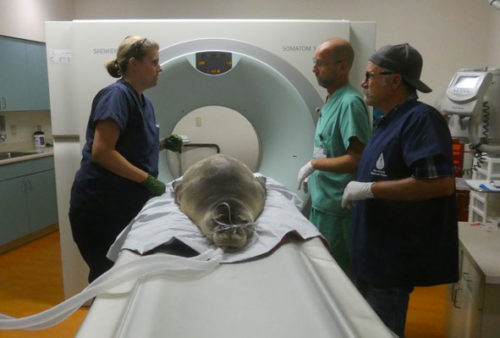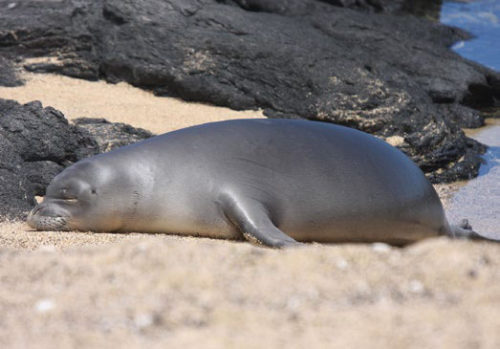The now-endangered Hawaiian monk seal is thought to have migrated to the Hawaiian Islands between four and 11 million years ago, long before any human settlers. Known to native Hawaiians as ‘Ilio-holo-i-ka-uaua, or “dog that runs in rough water,” it is the only seal native to Hawai`i. Adopted as Hawai`i’s state mammal in 2008, they’re so cute you want to walk right up and tickle their whiskers.
But no! That’s the last thing those working diligently to restore monk seal populations want you to do. The more human contact the worse.
“We use the ‘rule of thumb,’” says Patrick Kim, Response & Community Engagement Manager at The Marine Mammal Center in Kona. Kim holds his thumb up to eye level at arm’s length to demonstrate. “If you can see the monk seal behind your thumb you’re too close.” Seeing as how a healthy adult male weights 400-450 pounds and a healthy adult female weights 600-650 pounds, “too close” is typically anything less than 150 yards.
As monk seals are occasionally spotted at Waikoloa Beach Resort, the advice is pertinent. Turns out that Hawaiian monk seals — Neomonachus schauinslandi — are curious and not averse to human interaction. But as a conservation-reliant endangered species, human interaction has deadly consequences. Human encroachment on seal habitat has contributed to the dangerously low population now found in the wild.
Among the dangers they face: entanglement in fishing nets, fish hooks, marine debris, plastics, dis ease such as toxoplasmosis (transmitted only from the out-of-control feral cat population in Hawai`i), very low levels of genetic variation, and past commercial hunting for skins.
Of the 1,400 monk seals found in the wild today — up from an estimated 150 animals in 2004, demonstrating the success of the conservation program — only 300 live in and around the main islands, with the other 1,100 found in the Northwest Hawaiian Islands. Thankfully, the population is now somewhat stable due to the efforts of groups such as The Marine Mammal Center and its Kona- based hospital, Ke Kai Ola.
 “Even the loss of one birthing age female can have a tremendous impact,” says Hospital Director Claire Simeone, DVM. “That’s why we are so careful when we interact with them, even in the hospital setting. If they become too dependent on or used to human inter- action, they can put themselves in very dangerous situations in the wild.” Although it’s rare, there have been instances of people clubbing seals as they lie resting or nursing their pups on a beach. More often, Simeone intakes a monk seal that has been found injured in an interaction with a fishing net or a boat, or malnourished due to some other cause.
“Even the loss of one birthing age female can have a tremendous impact,” says Hospital Director Claire Simeone, DVM. “That’s why we are so careful when we interact with them, even in the hospital setting. If they become too dependent on or used to human inter- action, they can put themselves in very dangerous situations in the wild.” Although it’s rare, there have been instances of people clubbing seals as they lie resting or nursing their pups on a beach. More often, Simeone intakes a monk seal that has been found injured in an interaction with a fishing net or a boat, or malnourished due to some other cause.
The hospital staff feeds and cares for the animal with strict permitting and guidelines from the National Oceanic & Atmospheric Administration (NOAA) that call for as little human contact as possible. Precautions include performing any required medical procedures behind visual guards while the animal is sedated, observation of recovering patients behind one-way mirrored glass, and providing as much peace and quiet as they can.
“These precautions are critical,” says Simeone. “When we release our patients back into the wild, we want them to have as high a success rate as possible.”
A recent patient from Kaua`i, referred to as RH38 — giving the monk seals a number rather than a name is another example of how far the team goes to avoid creating seal-human intimacy — made news across the state when she was rescued for a second time.
 Turns out RH38’s second injury was not related to the first, and as of early June her recovery was going well. She received a CT scan — the first ever per- formed on a wild Hawaiian monk seal — and was tested for dozens of diseases, toxins, and parasites. She was eventually diagnosed with an injury in her back flippers that caused severe muscle inflammation and infection. If all goes as planned and RH38 continues to regain weight and health, she will be returned to her native waters in the near future. As the females give birth to one pup per year starting at age 5, the importance of the hospital effort becomes crystal clear.
Turns out RH38’s second injury was not related to the first, and as of early June her recovery was going well. She received a CT scan — the first ever per- formed on a wild Hawaiian monk seal — and was tested for dozens of diseases, toxins, and parasites. She was eventually diagnosed with an injury in her back flippers that caused severe muscle inflammation and infection. If all goes as planned and RH38 continues to regain weight and health, she will be returned to her native waters in the near future. As the females give birth to one pup per year starting at age 5, the importance of the hospital effort becomes crystal clear.
“This is where the future of the species is safeguarded,” Simeone says.
The hospital is also awaiting the return of a NOAA ship that takes a once-a-year cruise to the Northwestern Hawaiian Islands, all the way out to Laysan and Midway, observing and cataloguing monk seals in the wild and transporting any that are in need of medical attention back to the hospital in Kona.
Along the way, the ship deposits adventurous teams of volunteers on the distant islands and atolls for four- and-a-half month assignments to observe, tag, assess, and collect data on the monk seals.
If that sounds like your idea of fun, “Anyone can apply for one of these eld camps,” says Kim. “Just go to the NOAA website.”
If you’re not quite ready to camp on an atoll for 4.5 months in the middle of the Paci c, but still want to do your part to help save the Hawaiian monk seals, go to MarineMammalCenter.org/hawaii.

